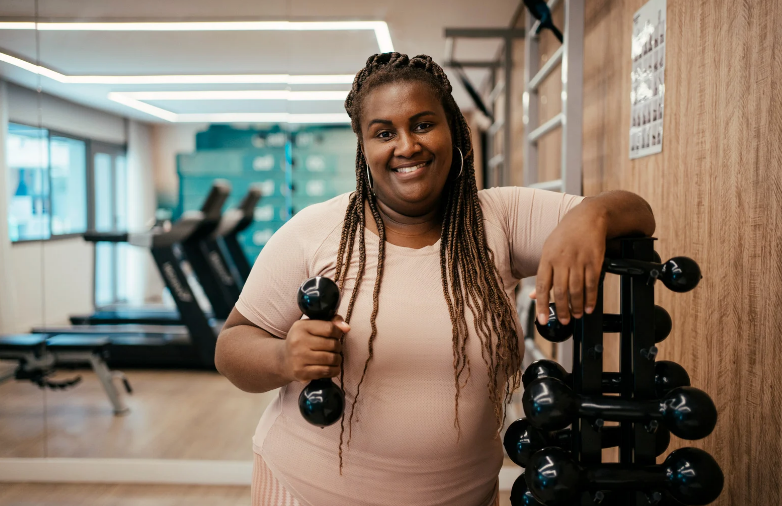
The beginning of a weight-loss journey can feel like you're at the bottom of a mountain and someone has asked you to start climbing. You don't have a map of the best path to travel, you're not sure what tools you need and it feels like it will take a lifetime to reach the top. Given
The term "weight-loss journey" implies that the changes aren't all going to happen overnight, and it's an implication that's important to remember. No one is telling you to run as fast as you can to the top of the mountain, even if finishing sooner than later sounds more appealing. Instead of setting your sights on the peak, take a deep breath and focus on the next 10 steps in front of you. What can you do in this moment to keep you moving forward toward a better version of yourself? It doesn't have to be much to start, and you'll be surprised at how you progressively learn to challenge your body.
With all the expectations, self-imposed pressures and confusion surrounding health strategies, it's normal to feel confused and defeated before you even get started—which is why we put together a step-by-step guide that will lead you through adopting a healthier lifestyle. Instead of focusing on all of these areas (or even some of them) at once, try one at a time. Pick one section and work through the three to four action steps for the first month. After month one is complete and you feel comfortable incorporating those healthy habits into your daily routine, pick another section. By the end of four months, you will have developed a healthy lifestyle that is well-rounded and easy to manage.
Healthy Habit #1: Improve Your Diet
- Track the food you've been eating. Instead of focusing on where you should be, focus instead on where you are right now. By tracking your food for a few days or even a few weeks, you'll get a baseline idea of how you're doing relative to your recommended calorie and nutrient ranges and, thus, where you need to make changes. Even better, you might find a few places where you can get some "easy wins." For example, switching from your fancy chocolate mocha to black coffee each morning saves almost 500 calories, or eating a small bag of chips instead of jumbo size
saves 300 calories on your afternoon snack. Making just a couple of changes can create a big calorie savings without a big overhaul to your diet. - Change your relationship with snacks. There is definitely a right and wrong way to snack. Snacks should be used as fuel, a way to bridge the gap between meals to keep your energy level high throughout the day. They should not be used to ease feelings of boredom or stress, or a chance to eat "because it's time." If you've planned for a snack in your day, be sure to choose something with healthy fat and/or protein, such as nuts, yogurt or half of a turkey sandwich. These types of snacks promote feelings of fullness and satisfaction.
- Replace two not-so-healthy foods in your diet with healthier options. The fastest way to fall off the healthy eating wagon is to deprive yourself of all the foods you enjoy. Instead of eliminating the unhealthy foods you really like, try replacing them with healthier options. For example, instead of a deep-dish pizza with extra cheese, opt for thin crust with extra veggies and lighter cheese. Instead of a turkey sandwich on a croissant smothered in extra cheese and
mayo , opt for whole-wheat bread, less cheese and hummus instead of mayonnaise. You'd be surprised at how many calories you can save while still enjoying the foods you love. - Choose one day to meal prep for the week ahead. When it comes to healthy eating, planning is everything. Don't get stuck with an empty belly and no healthy options in sight. Instead, choose one day (typically a weekend when you have more time) to shop for and prepare meals for the week ahead. Make a pot roast that you can serve with veggies, diced up in a soup and sliced on sandwiches during the week. Chop some vegetables, cook a batch of rice and have a can of beans and a few chicken breasts on hand to make a variety of healthy one-bowl meals. Don't feel like you need to plan every single meal for the week ahead of time either. Start with just lunches, then expand to snacks, breakfasts and finish with dinners as you perfect your strategy.
Healthy Habit #2: Move More
- Increase your number of steps throughout the day. You're familiar with the recommendation that each of us get at least 10,000 steps per day. If that seems like a lofty goal compared to how much you're currently moving, start slower. Determine the average number of steps you get in a day (using a fitness tracker, pedometer or other step-counting device) and aim to increase that number by 150. Then the next week, increase by another 150, and so on. You can accomplish this with an extra trip out to the mailbox, parking farther from the door at the grocery store or marching in place while brushing your teeth. Those steps add up
more quickly than you might think! - Schedule three cardio workouts this week. While it might sound like a lot if you've not been exercising regularly, start with just five to 10 minutes per session, if needed. Getting into the habit of scheduling workouts just like you'd schedule any other appointment in your day will help you become more consistent. Don't be afraid to try a variety of activities (such as walking, biking or swimming) until you find things you enjoy. The more you like what you're doing, the more likely you are to stick with it long-term. Set a goal to add five minutes per week to each workout session until you reach 30 to 40 minutes regularly.
- Schedule two strength-training workouts this week. Strength training is an important part of any well-rounded workout routine. As you lose weight, start strength training from the beginning. This ensures that more of the weight loss
comes from fat instead of muscle. But don't feel intimidated by the muscular bodies and foreign equipment in the weight room! You can start with a simple, 15-minute full-body routine to target all of your major muscle groups. Putting together your own routine doesn't have to be complicated, and as you learn more moves it will feel even easier.
Healthy Habit #3: Find Time to Focus
- Take a few technology breaks during the day. An endless stream of text messages, emails and social media alerts can leave you feeling frazzled throughout the day. Instead of instantly responding to messages, block off a few periods during the day where you go offline. Use that quiet time to gather your thoughts and complete important tasks. Your productivity will go up and your stress level will go down when you unplug for even a few minutes.
- Make a weekly to-do list of things you want to accomplish. Even if your list is just two to three of the most important things you want to do, committing to them makes it more likely that they will happen. Write down not only what you want to do, but the steps needed to get there and when each step will be completed as the week goes on. It's hard to reach your destination successfully when you don't have a roadmap to take you there.
- Work on getting enough sleep. The average adult needs seven to nine hours of sleep nightly for optimum health, but many of us consistently fall short. Lack of sleep has been associated with an increased risk of high blood pressure, heart disease and other health problems. Try going to bed 30 minutes earlier each night or winding down with a few minutes of meditation before bed to help you relax and fall asleep faster.
- Try a yoga class or other mindfulness activity. Although it's easy to dismiss an activity like yoga as something that's too intimidating or just not your thing, a regular yoga practice that gives you time to settle your mind, focus on your breathing and relax is beneficial in our fast-paced world. You don't have to commit to a 90-minute class at a yoga studio to get started. Instead, try 15 minutes of a yoga video on YouTube or a five-minute mindfulness activity in the comfort of your home at the end of the day. You'll be amazed at the benefits that come with adding this type of activity to your routine even just once a week.
Healthy Habit #4: Live Your Best Life
- Reach out to a friend or family member and share your healthy living goals with them. Changing lifelong habits can be a challenge, but knowing those around you are supporting and cheering you on can make such a big difference. Ask a friend to check in on you once a week and see how things are going. Plan a reward for reaching a small goal and ask a family member to celebrate with you. Getting others involved and creating a support system gives you a shoulder to lean on when times are tough and people
to cheer you on when things are going well. - Identify an activity that helps you relieve stress and do it twice this week.
Stress is that silent little monster that can take over your life without you even realizing. With so many demands on your time and commitments to fulfill, it can be hard to find time to decompress. It's tempting to indulge in a bag of chips orpint of ice cream at the end of a hard day, but will that make you feel better in the long run? Probably not. Focus on finding a healthier way to deal with the stress in your life, whether that's finding an activity you enjoy (such as reading or writing), or just taking a few minutes to breathe deeply and relax. - Write down three things you're grateful for each day. Research has shown that people who express gratitude are happier and healthier. Take a few minutes each night to jot down your appreciation of a kind word from a co-worker, your kids cleaning up their dishes without being asked or the beautiful sunset this evening. By noting the good things happening in your life, big or small, it helps you realize you have so many things to be thankful for.













